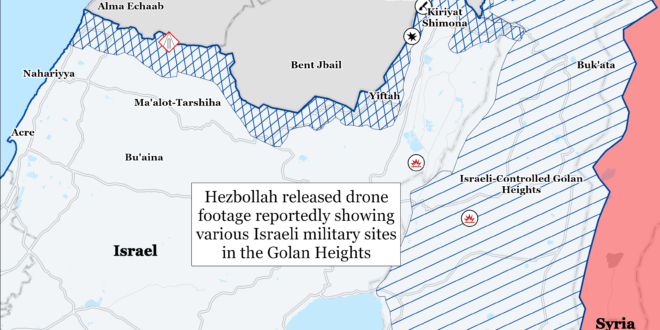Hamas is threatening to end ceasefire negotiations with Israel in response to Israeli raids targeting Hamas fighters in Gaza City. This effort may seek to trigger increased international pressure on Israel to stop the raids. Hamas Political Bureau Chairman Ismail Haniyeh said on July 8 that continued Israeli raids in Gaza City and Rafah would end the current Israel-Hamas ceasefire negotiations.[i] Israel launched a raid in Tal al Hawa in southwest Gaza City on July 8 to target Hamas fighters, dismantle militia infrastructure, and destroy weapons caches.[ii] Israel is conducting raids on a UNRWA headquarters in Gaza City that Hamas and Palestinian Islamic Jihad (PIJ) have used to detain individuals, shelter fighters, and store weapons.[iii] Israeli forces also sought to locate and destroy militia safehouses and other sheltered positions during the raids.[iv] Haniyeh’s statement suggests Hamas is concerned that the Israeli raids could severely disrupt Hamas’ capabilities in the area. Haniyeh and Hamas may assess that threatening to end negotiations over Israeli action will cause the mediators to increase pressure on Israel to slow or cease operations to save the deal. Hamas will likely survive an Israeli operation in Tal al Hawa because it is able to relocate fighters and resources to other areas of the Gaza Strip and infiltrate areas after Israeli forces have completed clearing operations. Israeli operations do damage Hamas, however, and this statement suggests that Hamas seeks to decrease Israel’s ability to conduct these raids at will.
Hamas has begun transporting unspecified equipment to Baghdad International Airport in preparation for relocating its political leadership to Iraq, according to an unspecified senior Shia Coordination Framework member.[v] The politician claimed that Iranian-backed Iraqi militia Asaib Ahl al Haq Leader Qais al Khazali and Iranian-backed Badr Organization Secretary General Hadi al Ameri met on July 8 to discuss Hamas’ potential relocation to Baghdad. The politician noted that unspecified Shia factions are divided over whether the Iraqi federal government should allow Hamas to move to Iraq. Emirati media reported on June 24 that Hamas plans to relocate its political leadership to Iraq due to growing pressure from the United States and Qatar on Hamas to show greater flexibility in ceasefire negotiations with Israel.[vi] Emirati media noted that Iran would be responsible for protecting Hamas personnel and offices in Iraq. The Emirati report followed the opening of a Hamas political office in Baghdad in early June 2024.[vii]
Key Takeaways:
- Hamas: Hamas is threatening to end ceasefire negotiations with Israel in response to Israeli raids targeting Hamas fighters in Gaza City. This effort may seek to trigger increased international pressure on Israel to stop the raids.
- Hamas in Iraq: Hamas has begun transporting unspecified equipment to Baghdad International Airport in preparation for relocating its political leadership to Iraq, according to an unspecified senior Shia Coordination Framework member.
- Lebanon: Hezbollah released drone footage on July 9 reportedly showing various Israeli military sites in the Golan Heights.

Gaza Strip
Axis of Resistance objectives:
Erode the will of the Israeli political establishment and public to sustain clearing operations in the Gaza Strip
Reestablish Hamas as the governing authority in the Gaza Strip
The Israel Defense Force (IDF) 98th Division located offensive tunnels leading to the Israeli border while conducting clearing operations in Shujaiya on July 9.[viii] The IDF located six tunnels in Shujaiya with a total length of approximately six kilometers. The IDF also said that two of the tunnels extended to the Israeli border near Nahal Oz.[ix] The IDF said that Palestinian Islamic Jihad (PIJ) used one 2.5 kilometer tunnel to facilitate command-and-control. An Israeli Army Radio correspondent reported that the IDF found indicators that Hamas and PIJ have attempted to restore command-and-control capabilities in Shujaiya.[x] The IDF killed several fighters, located weapons, and destroyed tunnels.[xi] The IDF said on July 9 that it has killed 150 fighters in Shujaiya since the IDF launched the operation on June 27.[xii] Palestinian militia groups have exploited the IDF raid-based model to preserve its forces and enable future reconstitution efforts, as CTP-ISW has previously assessed.[xiii]
Palestinian militias, including Hamas and PIJ, engaged Israeli forces in Tal al Hawa, southwest Gaza City, on July 9.[xiv] Palestinian militias targeted Israeli forces with small-arms, mortars, improvised explosive devices (IED), and thermobaric rockets. The IDF 99th Division launched a raid in the area on July 8.[xv]
Israeli Air Force (IAF) fighter jets struck Hamas and PIJ fighters in a school complex in Nuseirat camp on July 8.[xvi] The IAF have continued airstrikes on militia infrastructure and tunnels across the Gaza Strip since CTP-ISW’s last data cut off on June 8.[xvii]
The IDF 162nd Division continued clearing operations in Rafah on July 9.[xviii] Israeli forces directed airstrikes targeting Palestinian fighters and killed fighters in close-range combat.[xix] PIJ and the National Resistance Brigades mortared Israeli forces operating in Rafah.[xx]
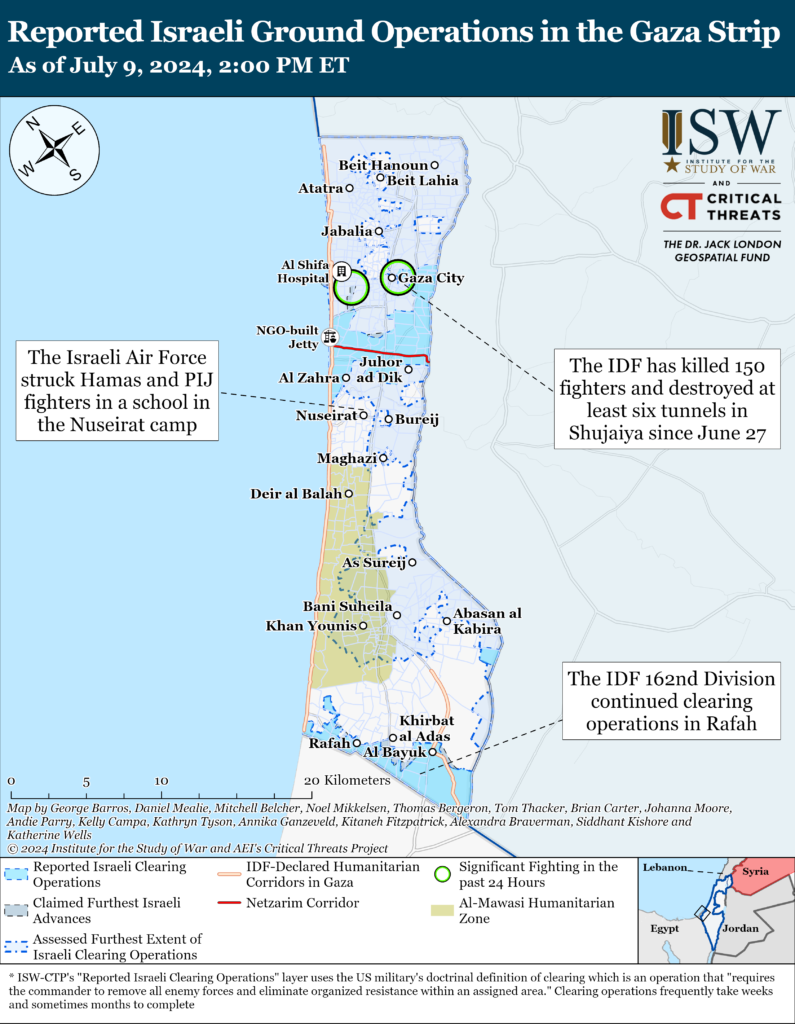
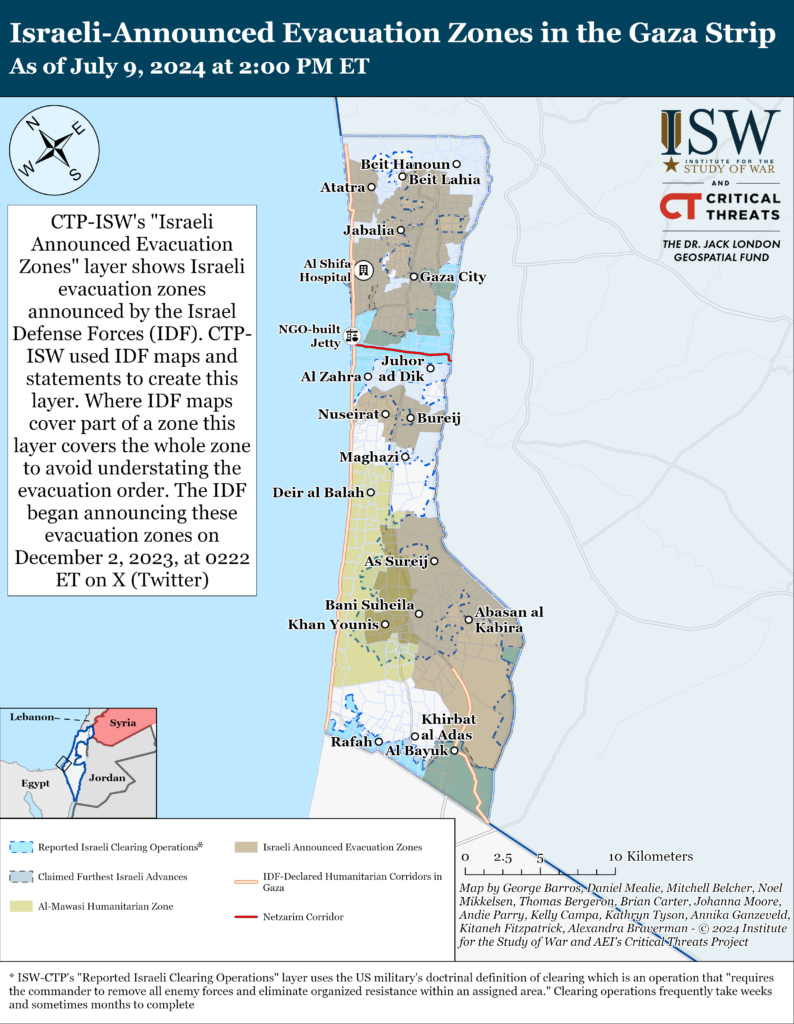
Palestinian militias have conducted two indirect fire attacks into southern Israel since CTP-ISW’s last information cutoff on July 8.[xxi] PIJ and the Nasser Salah ad Din Brigades conducted separate rocket attacks targeting Nir Yitzhak and the Fajjah military site, respectively.[xxii]
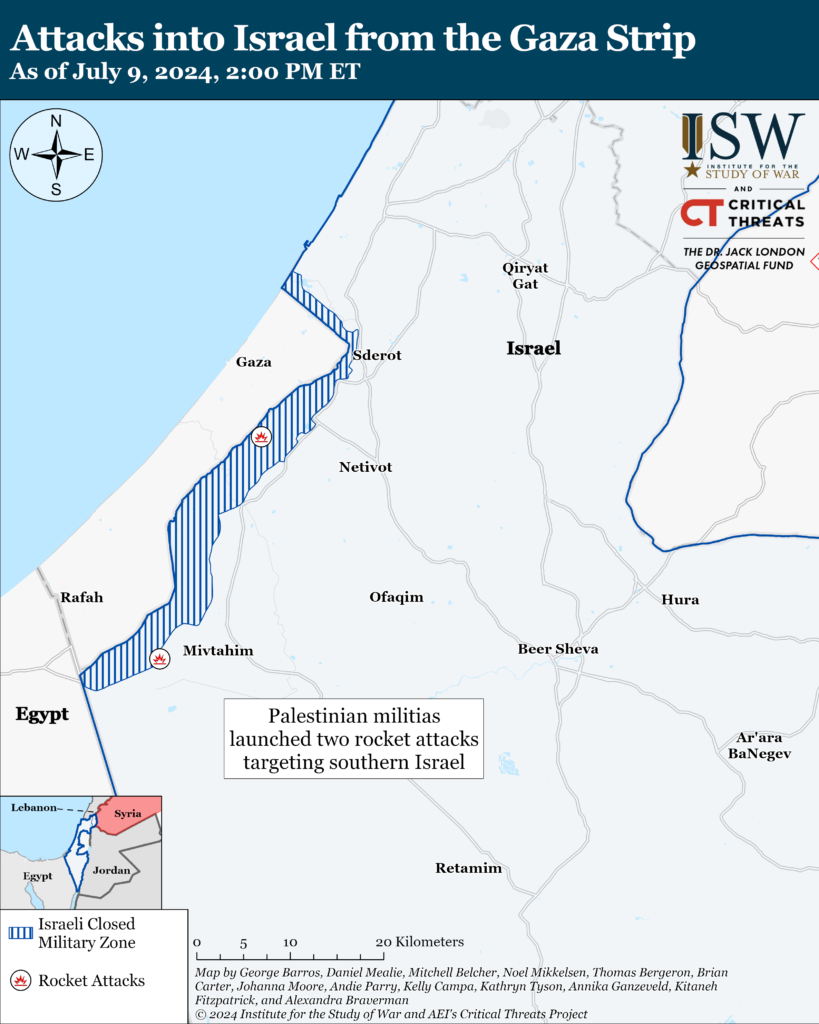
West Bank
Axis of Resistance objectives:
Establish the West Bank as a viable front against Israel
Israeli forces have engaged Palestinian fighters in at least eight locations in the West Bank since CTP-ISW’s last data cut-off on July 8.[xxiii] The IDF reportedly detained 15 wanted persons across the West Bank.[xxiv] The Mujahideen Movement targeted an IDF outpost near Beit Ummar, north of Hebron, with IEDs.[xxv]
The IDF destroyed a vehicle rigged with explosives during an overnight raid in Nour Shams Refugee Camp on July 8.[xxvi] Israeli forces conducted an “extensive” overnight raid in Nour Shams Refugee Camp and destroyed “dozens” of IEDs.[xxvii] Palestinian media reported that the IDF raid in Nour Shams Refugee Camp lasted for at least fifteen hours.[xxviii] Unspecified Palestinian militias previously detonated a vehicle-borne improvised explosive device targeting Israeli forces in Tulkarm on January 4, 2024.[xxix]
The al Aqsa Martyrs’ Brigades, PIJ, and the Mujahideen Movement fired small arms and detonated IEDs targeting Israeli forces in Nour Shams Refugee Camp.[xxx]
Palestinians held demonstrations in Nablus and Jenin to show support for Palestinian prisoners held in Israeli prisons.[xxxi]
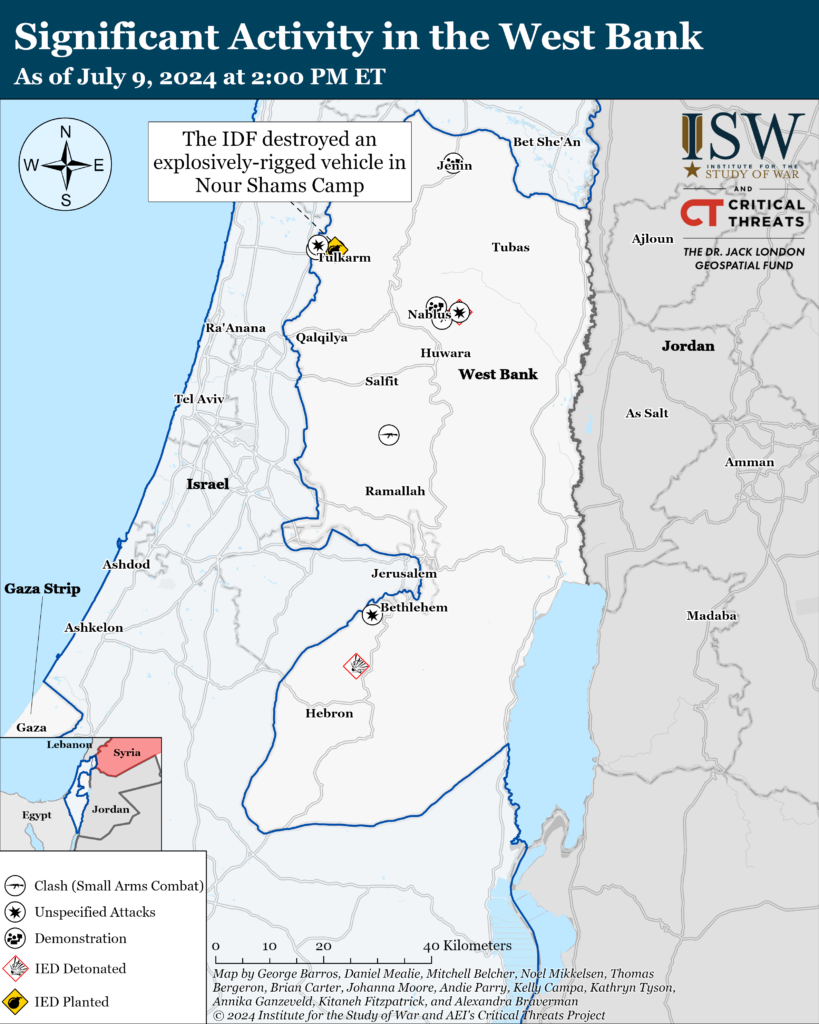
Southern Lebanon and Golan Heights
Axis of Resistance objectives:
Deter Israel from conducting a ground operation into Lebanon
Prepare for an expanded and protracted conflict with Israel in the near term
Expel the United States from Syria
Lebanese Hezbollah conducted at least six attacks from southern Lebanon into northern Israel since CTP-ISW’s last data cut off on July 8.[xxxii] Hezbollah attacked Israeli civilians and military sites in retaliation for an Israeli strike in southern Lebanon.[xxxiii]
Hezbollah released drone footage on July 9 reportedly showing various Israeli military sites in the Golan Heights.[xxxiv] The footage identifies Israeli surveillance equipment, early warning radars, artillery positions, Iron Dome batteries, and IDF brigade headquarters. Hezbollah released similar drone footage showing Israeli military sites in Haifa and other areas of northern Israel on June 18.[xxxv]
Israel likely conducted an airstrike targeting an Iranian weapons shipment near Baniyas, Tartous, on July 9. The Syrian Ministry of Defense stated that Israel conducted an airstrike targeting an unspecified site near Baniyas city.[xxxvi] Syrian media reported Israel targeted a weapons shipment near Jableh, a town located near the port of Latakia and the Russian-controlled Hmeimim Military Airport.[xxxvii] Syrian media noted that the attack followed the arrival of Iranian shipments to the port of Latakia.[xxxviii] CTP-ISW has previously assessed that Iran and Russia are likely coordinating to transport Iranian materiel to Lebanon and Syria through Hmeimim Military Airport.[xxxix] Syrian and Israeli officials recently noted that the objective of Israel’s air campaign in Syria is to halt Iranian-backed efforts to transfer military materiel to Hezbollah before a potential full-scale conflict.[xl]
Israel also likely conducted an airstrike targeting a Lebanese Hezbollah official near the Syria-Lebanon border in Rif Dimashq, Syria, on July 9. Syrian media reported that Israel conducted a drone strike targeting a vehicle on the Damascus-Beirut road in Saboura, Rif Dimashq.[xli] An anonymous Hezbollah official identified one of the strike’s casualties as Yasser Namr Karanbish, a former bodyguard of Hezbollah leader Hassan Nasrallah.[xlii] Reuters reported that Karanbish had become a mid-ranking Hezbollah official recently involved in transporting weapons, citing two security sources.[xliii] Hezbollah posted a tribute commemorating Karanbish’s death.[xliv]
Hezbollah launched a heavy barrage of Katyusha rockets targeting an IDF site in the Golan Heights in response to Karanbish’s killing.[xlv] The IDF detected approximately 40 launches from Lebanon into the central Golan Heights.[xlvi] Two Israelis were killed by falling munitions near Nafah Junction.[xlvii]
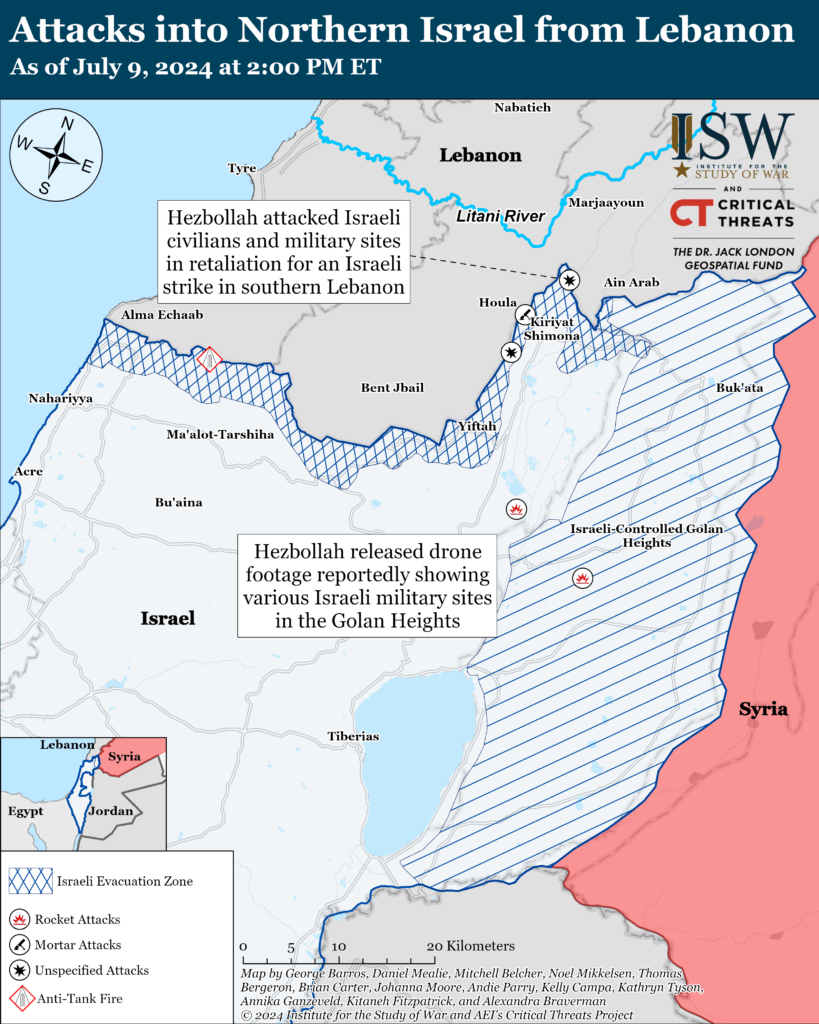
Iran and Axis of Resistance
ADD NOTE
TWEET
Iranian president-elect Masoud Pezeshkian held phone calls with Iraqi and Pakistani leaders on July 8 and 9. Pezeshkian discussed strengthening relations between Iran and Iraq in separate calls with Iraqi Prime Minister Mohammad Shia al Sudani and Iraqi President Abdul Latif Rashid.[xlviii] Pezeshkian also reaffirmed Iran’s commitment to developing Iranian-Pakistani relations and joint border security during a call with Pakistani Prime Minister Shahbaz Sharif on July 9.[xlix] Pezeshkian added in the phone call with Sharif that the supreme leader and the Iranian government consider the development of relations with Pakistan as an ”inviolable principle” of Iranian foreign policy.
US Ambassador to Iraq Alina Romanowski and US Deputy Assistant Secretary of Defense for Middle East Policy Dan Shapiro met with senior Iraqi officials in Baghdad on July 8 and 9 to discuss US-Iraqi security and military relations. Romanowski and Shapiro held separate meetings with Iraqi Prime Minister Mohammad Shia al Sudani, Foreign Affairs Minister Fuad Hussein, and Defense Minister Thabet al Abbasi.[l] The US and Iraqi officials discussed upcoming Higher Military Commission meetings, which are part of ongoing negotiations between Iraq and the United States to evaluate the status of the US-led international coalition to Iraq.[li] The United States and Iraq began these negotiations in January 2024.[lii]
The Islamic Resistance in Iraq—a coalition of Iranian-backed Iraqi militias—claimed on July 8 that it conducted a combined drone attack with the Houthis targeting an unspecified “vital target” in Eilat, Israel.[liii] This attack marks the eighth time that the Islamic Resistance in Iraq has conducted a combined attack targeting Israel with the Houthis since early June 2024. The IDF intercepted a “suspicious aerial target” that was heading toward Israel over the Red Sea on July 7.[liv] The object did not enter Israeli airspace. The Islamic Resistance in Iraq separately claimed two drone attacks targeting unspecified “vital targets” in Eilat and Haifa on July 8 and 9, respectively.[lv] The IDF also intercepted a “suspicious aerial target” that was heading toward southern Israel from the east on July 8.[lvi]
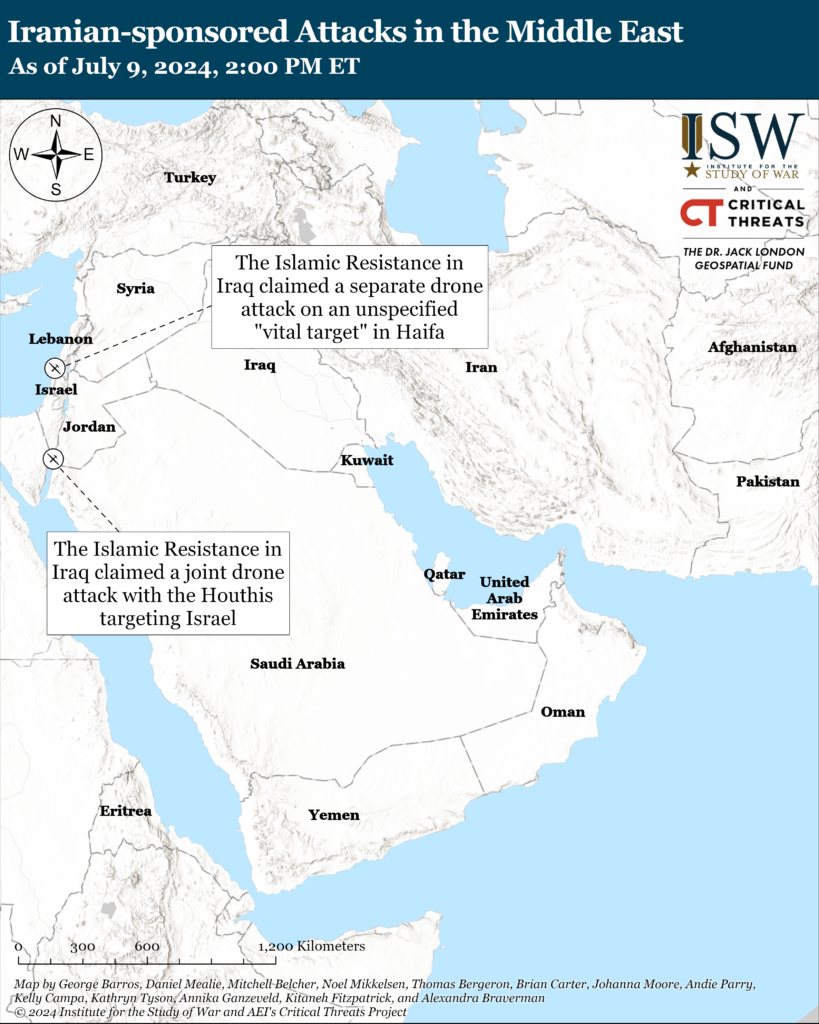
United Kingdom Maritime Trade Operations (UKMTO) reported an explosion occurred near a merchant vessel 180 nautical miles east of Nishtun, Yemen, on July 9.[lvii] The explosion did not cause any injuries or damage to the vessel, and the vessel continued to its next port of call.
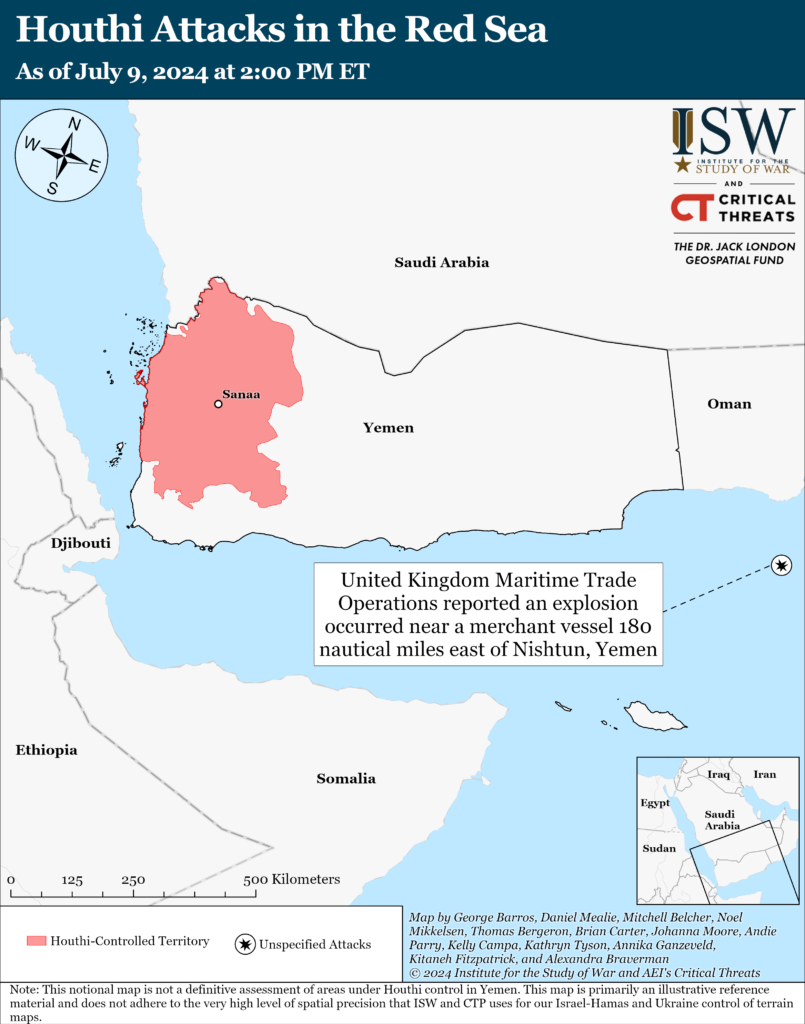
 Eurasia Press & News
Eurasia Press & News
